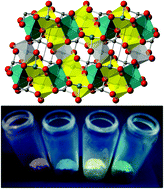Dopant and excitation wavelength dependent color-tunable white light-emitting Ln3+:Y2WO6 materials (Ln3+ = Sm, Eu, Tb, Dy)†
Abstract
Microstructured Y2WO6 materials were prepared in a hydrothermal synthesis in the presence of glycerol, which was employed as both a solvent and a structure directing agent, after which they were heat treated at 1100 °C. These materials, similar to other previously reported Y2WO6 as well as other rare-earth tungstate structures, showed interesting luminescence properties. Six Ln3+ doped or co-doped samples, which showed white light emission, are described in this paper. It was observed that the doping ion(s)/doping percentage, heat treatment of the material, as well as the chosen excitation wavelength could be used to tune the emission color of the samples to obtain white light with a warmer or colder undertone. The luminescence lifetimes, quantum yields, CIE coordinates and correlated color temperatures for these samples were determined. Additionally, for the co-doped Y2WO6 samples the energy transfer mechanisms were proposed because a significant change in the luminescence properties was observed after heat treatment. This can be linked to the conversion from distorted tungstate groups in the precursor material to regular tungstate groups in the heat treated material.


 Please wait while we load your content...
Please wait while we load your content...